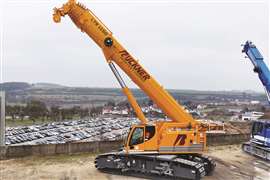Max Bögl erects world’s tallest turbines
29 August 2017

Specialist lifting contractor Max Bögl in Germany is erecting the world’s tallest wind turbines.
They are part of an energy storage project on which the company is using its fleet of Liebherr mobile cranes. The turbines stand on large concrete water storage basins that are 40 metres tall, contributing to the 240 m overall height of the turbines.
Max Bögl is erecting the four turbines near Schwäbisch Hall in the north-east of Baden-Württemberg, Germany. Additional electricity will be generated when demand is high in combination with a pump accumulator power plant in the Kocher Valley nearby.
A Liebherr LTM 11200-9.1 wheeled mobile hydraulic crane (one of four in the Max Bögl fleet) is lifting and placing the 27 prestressed concrete rings for each basin. Loads of more than 90 tonnes are being lifted by the crane which is rigged with 202 tonnes of ballast.
With the four concrete segments assembled into a 16 m diameter ring they are then stressed using steel cables. After building up the height in 1.5 m courses, the same crane will be used to install the turbine tower sections on top of foundations which are inside the tanks. Its other task will be to assemble the 630 EC-H 70 top slewing tower crane, also a Liebherr, for the remaining work on the project. The saddle jib tower crane will then be climbed to a height of around 190 m.



